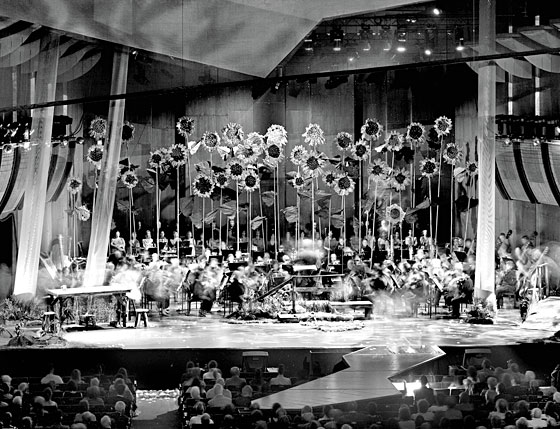
It’s been a desperate time in a classical-music world pummeled by strikes, deficits, and closures, but when the New York Philharmonic closed out its season with Doug Fitch’s merrily ambitious production of Janácek’s opera The Cunning Little Vixen, misery took a holiday. Giant sunflowers dominated the stage; children in beasties costumes hopped, slithered, and sang; Isabel Bayrakdarian shook her furry tail and embodied the Platonic ideal of a soprano fox. The orchestra, lurking behind a stand of tall grass and a wooden fence, played with the sharp, confident charm of an ensemble that knows why it matters.
The mission is to make symphonic music not a precious pursuit of specialists but a crucial part of a complex culture. At the end of his second year as music director, Alan Gilbert is renewing the genre’s claim for attention rather than dwelling on its eroded prestige. Instead of performing contemporary works out of a grudging sense of duty, he uses them as a come-on for a curious public. When the orchestra staged György Ligeti’s spectacularly weird and electrifying opera Le Grand Macabre last year, nearly 30 percent of the audience was attending its first New York Philharmonic concert.
I suspect many of those newbies returned in October for Kraft, a rapturously controlled explosion of clangor by the Philharmonic’s resident composer Magnus Lindberg. Percussion instruments scavenged from a Staten Island junkyard were scattered around the auditorium, their huge, demolition-derby fortissimos and puckish clicks enveloping the audience. The musicians were in constant motion. Principal cellist Carter Brey vaulted off the stage and sprinted up the aisle to pound an enormous nitrogen tank upended in the middle of the hall. Brass players marched away to offstage stations; percussionists filed through the hall clanging Chinese gongs.
Such evenings of joyous racket give the orchestra a daredevil swagger and chip away at a mountain of toxic misconceptions: that classical-music concerts are snobbish, rarefied, preposterously expensive affairs governed by rules of decorum that only the initiated can parse. Mere excellence used to be enough; an orchestra that swooped nimbly through a Brahms symphony, its strings resplendent and brass ablaze, could count on the loyalty of its local aristocracy. But even as the industrial cities that nurtured America’s great orchestras shrink and audiences drift away to other forms of culture, the players keep upping the ante on virtuosity. These days, technical perfection is the equivalent of running water: It attracts attention mostly when it’s lacking.
So, like many of its peers, the Philharmonic duly tweets, blogs, posts, streams, and uploads live recordings to iTunes. More effective than the whole arsenal of buzz, though, is the most venerable way to foment excitement: consecrating the two hours an audience spends in the concert hall to an experience that courses through the body, prods the mind, and energizes the spirit. Gilbert packages luxury performances of standard masterpieces in startling ways. One program in April opened with the pianist Emanuel Ax playing Debussy’s delicate “Pagodes” (from Estampes), followed by Messiaen’s mystical tableau of stained-glass hues, Couleurs de la cité céleste. That first half tuned the audience’s ears for the overwhelming accumulation of details in Mahler’s Symphony No. 5. Gilbert avoided the relentless application of pathos, focusing as much on the score’s winsome moments as on its tragic spasms. His hammer strokes fall a little more gently than those of his more fiercely dramatic contemporaries, and his cutoffs are a little less violent, but those half-shades of feeling gather into a slow crescendo of excitement.
Lately, the Philharmonic—traditionally the reliable second-best to the international parade of ensembles that file through Carnegie Hall—manages to avoid the humdrum even when it would suffice. In May, the orchestra returned to its ancestral home to celebrate Carnegie’s 120th anniversary with An American in Paris. The musicians could have coasted mindlessly; instead, they made Gershwin’s festive chestnut jell into a taut and clamorous celebration of urban life.
The Philharmonic still has plenty of work to do. Its twice-a-year new-music series “Contact!” barely stands out in the calendar of composer-driven events. Subscription concerts are selling at a respectable but unspectacular 82 percent of capacity, and it’s hard to know how many first-time ticket buyers are being converted into regulars. But Gilbert’s ambitions are clear and his gambles shrewd, and he is letting his vision mature. He’s playing the long game.
